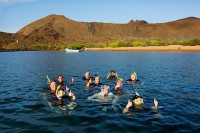Frequently asked questions
Galápagos Climate
Due to the confluence of cold water currents from the west and the south, the Galapagos archipelago has an uncharacteristically dry and moderate climate for the tropics and is generally classified as sub-tropical. This makes traveling to Galapagos a year-round vacation option. The weather is considered equatorial, cooled by the Humboldt Current, and is characterized by two main seasons:
June to November is generally called the "dry season" which is known for its blue skies and mid-day showers.
December to May is considered the "warm season". During this warmer season, the Galapagos' climate is more tropical with occasional showers with shiny skies.
| June to November | ||
| Temperature | 70ºF to 80ºF | (21ºC to 27ºC) |
| Water temperature | 65ºF to 75ºF | (18ºC to 24ºC) |
| December to May | ||
| Temperature | 80ºF to 90ºF | (27ºC to 32ºC) |
| Water temperature | 70ºF to 80ºF | (21ºC to 26ºC) |
Since the Islands are situated very near the Equator, we recommend you to bring lightweight clothes. It can get chilly at night, so a lightweight warm top/jacket is also recommended. Bring your swimming suits, sunscreen, and good footwear.
In The Galapagos Islands you will have plenty of breathtaking and amazing shots so a camera is a must.
There are two airports in Galapagos, Seymour Airport in Baltra Island and the Puerto Baquerizo Airport in San Cristobal Island which receive flights from mainland Ecuador. Commercial flights depart daily from Quito and Guayaquil in the morning, while return flights take place in the afternoon.
There are no International airlines that arrive directly to the Galapagos Islands. Flights depart daily from mainland either from the city of Quito or Guayaquil. Three airlines (Aerogal,LAN and TAME) provide this service.
Private flights can also arrive to either airport but must do immigration in the mainland before departing to the Galapagos.


